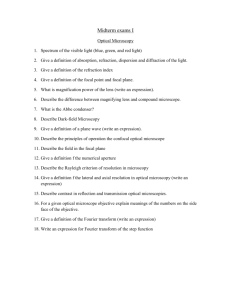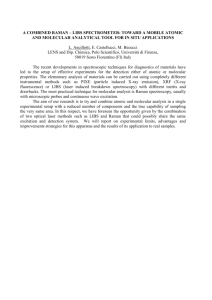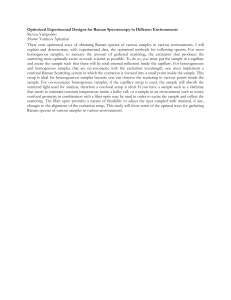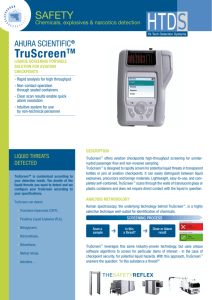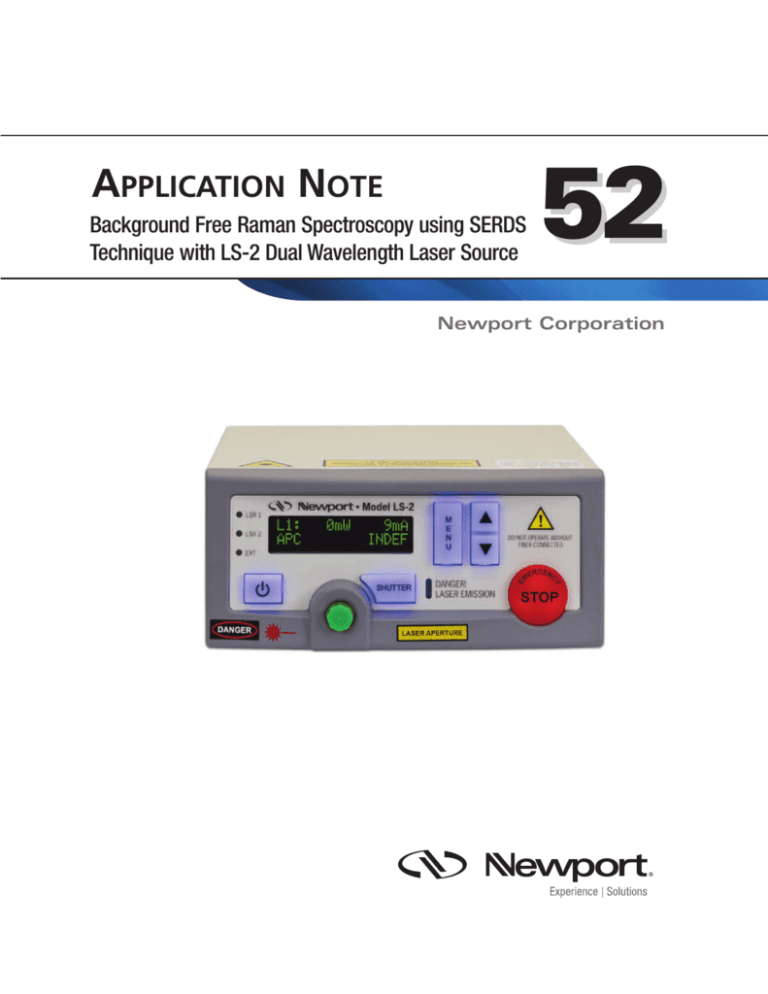
APPLICATION NOTE
Background Free Raman Spectroscopy using SERDS
Technique with LS-2 Dual Wavelength Laser Source
52
Newport Corporation
Introduction
Raman spectroscopy has been experiencing a period of
growing interest for qualitative and quantitative analysis in a
vast scope of applications pertinent to various industries,
including pharmaceuticals [1-5], petrochemical [6-8] and law
enforcement [9-13]. This growth is enabled by increase in the
offering of affordable Raman instrumentation, some are
portable and ruggedized for field use. Such increase in
availability and portability is powered in turn by compact,
high-performance wavelength-stabilized laser diodes.
However, with widening of the scope of applications for
Raman spectroscopy the challenge of sample fluorescence
becomes more and more evident. Besides the natural
fluorescence that many substances possess, there are issues
of sample contamination with fluorescent compounds in the
field that one must deal with in real life situations [9-10]. One
example of that is fluorescent agents such as caffeine and
flour regularly used in cutting illicit street drugs [10].
Although the long-wavelength, typically 1064 nm, Raman
instruments have been considered the benchmark in dealing
with fluorescent substances, working with that excitation
wavelength presents a number of issues. First of all, as is well
known, the Raman signal diminishes as the 4th power of laser
wavelength, which means that it is ~ 3.4 times weaker with
1064 nm excitation as compared with commonly used 785 nm
excitation. Generally it means that significantly longer
collection times are necessary to collect as much Raman
signal when using 1064 nm laser. Furthermore, the use of 1064
nm excitation laser requires using InGaAs detectors instead of
silicon CCDs. In case of dispersive Raman systems these are
InGaAs arrays, which typically have much higher thermal
noise than that of a silicon CCD at the same temperature. As
a result, InGaAs detector arrays for dispersive Raman
instruments must always be cooled to lowest practical
temperature to achieve satisfactory noise levels. Although
cooling the detector is not a technical obstacle for laboratory
instruments, it presents an obvious issue for portable,
battery-operated Raman instrumentation, as it means more
power consumption, larger battery and shorter battery life, in
addition to increase in cost and complexity of the instrument.
For that reason a lot of attention has been paid over the years
to other methods of combating fluorescence in Raman
measurements, which can be separated into two classes: 1)
the digital filtering methods; and 2) the physical methods of
subtracting fluorescence contribution from the Raman signal,
of which the Shifted Excitation Raman Difference
Spectroscopy, or SERDS, is the prime example.
Shifted Excitation Raman Difference
Spectroscopy
The underlying principle of the SERDS is the fact that Stokes
and Anti-stokes components of the Raman scattering are
frequency-shifted relative to the excitation wavelength and,
therefore, are tied to it. Laser-induced fluorescence, on the
other hand, is independent from the excitation wavelength
and retains practically identical spectral shape when the
excitation wavelength experiences a relatively small change (<
10 nm, for example). For that reason if two spectra are
collected with a small shift in the excitation wavelength and
subsequently subtracted, the resultant spectrum will be free
from the fluorescence contribution, while retaining the Raman
signal, albeit in a form of a difference spectrum (Fig. 1).
Figure 1. Illustration of the principle of SERDS.
For this ability of accurate subtraction of the fluorescence
background the SERDS approach has long been considered
attractive, effectively expanding the use of the conventional
dispersive Raman instrumentation equipped with inexpensive
and efficient CCD detectors to the classes of samples that
exhibit strong fluorescence.
SERDS method was proposed and tested over time in various
application areas generally with good success with respect to
eliminating the fluorescence background and extracting the
Raman signal from it. In majority of the studies conducted on
SERDS large emphasis was put on the reconstruction of the
Raman spectrum of the substance under study from the
pseudo-derivative one obtained as a product of SERDS
process. As a result, the often quoted drawbacks of SERDS
method are in fact the deficiencies of the various
reconstruction algorithms. At the same time it is a wellunderstood fact that reconstruction is not required for any of
the numerical algorithms involved in substance identification,
detection or quantitative measurements by means of Raman
spectroscopy. When the need of spectrum reconstruction is
removed, SERDS approach will deliver clearly superior
performance to any of the numerical processing algorithms
designed to eliminate the slowly varying fluorescence
background.
2
Historically the SERDS method has been used in laboratories
employing tunable-wavelength lasers. However, the use of
this type of laser sources presents a significant challenge for
portable Raman systems. Generally these lasers are much
more costly than simple and efficient wavelength-stabilized
laser diodes. But in addition to this there is an issue of the
exact wavelength control over these lasers required to perform
accurate qualitative and especially quantitative Raman
analysis, as it is not fixed or stable, which requires constant
active wavelength monitoring for accurate analysis. For these
reasons we offer a comparatively much more simple and
practical approach to performing SERDS analysis using two
affordable wavelength-stabilized laser diodes operating at
slightly offset wavelengths. The lasers are stabilized by use of
the Volume Bragg Grating (VBG) technology and are very
compact, efficient and inexpensive, making them well-suited
for portable battery-operated Raman instrumentation.
Advantages of SERDS
The most important advantage of the SERDS method over the
conventional methods of digital removal of the fluorescence
background is accurate elimination of the fluorescence
contribution, as opposed to approximation of such using a
polynomial function, as is the case in baseline fitting, for
example. This advantage is particularly obvious when the
background fluorescence has some spectral features, but even
in the situations when the fluorescence has a slowly varying
smooth shape the advantages of SERDS are very apparent.
Using two fixed wavelength VBG-stabilized laser sources is a
particularly simple and efficient method of implementation of
SERDS. Such sources are now available in high brightness and
high power at a variety of wavelengths, and are very reliable
and stable in wavelength over the lifetime of a device. These
lasers do not require constant wavelength monitoring as their
wavelength is known and stable.
Availability of such sources in a wide range of spectrum, from
the 400 nm to the near IR, is another convenient feature,
which allows the end user the freedom of choice of the
excitation wavelength. Since these laser sources are compact,
they are very compatible with field-portable Raman
instruments, which presents an important advantage, as the
signal collection in the field is often not free from background
light and the samples are often not pure, thus increasing the
likelihood of encountering interference from the fluorescence
of the contaminants.
Being able to analyze fluorescent samples while using the
preferred, i.e. shorter, excitation wavelength has the
advantage of being able to use silicon CCD detectors, which
have high sensitivity, lower thermal noise and low price tag
associated with them.
Furthermore, SERDS can be implemented without any
changes to the Raman probe and spectrometer hardware,
making it simple and versatile for equipment manufacturers.
When equipped with silicon CCD, even a portable Raman
instrument will have higher resolution and faster signal
processing times then even laboratory-size long-wavelength
Raman instruments. Because the Raman signal is so much
stronger at shorter wavelengths the signal collection times are
often many times faster for 785 nm systems, for example, as
compared with the 1064 nm system at similar laser
illumination intensities.
As the signals for the two excitation wavelengths are collected
in rapid succession, the SERDS method does not require
collecting the background signal independently, as it is
automatically corrected for it during the subtraction of the two
collected spectra.
And finally, for majority of the practical applications the
differential shape of the SERDS spectra is very convenient, as
the spectra are naturally centered (i.e. have zero integral) and
are nearly orthogonal for dissimilar substances. This feature
makes them very fitting for all automatic signal processing
algorithms, be it quantitative Raman, impurity detection or
unknown substance recognition.
Experimental
The SERDS measurements are performed using a dual-laser
SERDS laser source, LS-2, produced by Newport. The lasers
operate at two closely spaced wavelengths, which in the case
of the measurements shown here are 784.5 nm and 785.5 nm.
The wavelength separation is selected to correspond to the
approximate line width of the Raman lines of the substances
under study. Note that the exact wavelength separation is not
significant for the accuracy and practicality of SERDS,
however, wavelength separation that is much smaller than the
width of the Raman bands would result in increase in noise in
SERDS spectra.
The LS-2 laser source delivers the output of either one of the
two lasers to the output port via a fiber-optic switch. A fiberoptic cable is then attached to the output port of the LS-2 and
coupled into a Raman probe or a bench-top Raman system
(Fig. 2). The system is designed to accept a fiber-coupled input
from a laser source, which is then collimated by an aspheric
lens. After the lens there is a laser clean-up filter (a 3 nm
bandpass filter) which serves to cut down the amplified
spontaneous emission from the laser source as well as the
Raman signal from the delivery fiber. Since the system is using
larger aperture components and longer distances, lens relays
are employed in order to properly guide the laser and, most
importantly, signal light throughout the system. The first lens
relay is comprised of lenses RL1 and RL2, which project the
front focal plane of the laser collimating lens onto the front
focal plane of the sample focusing/collection lens. The laser
light is folded by a fold mirror and the first notch filter and
then one more time by a pentaprism installed in a rotating
3
swivel mount. This is done in order to have the flexibility of
pointing the laser down, up or horizontally, depending on the
type of a sample being studied, without affecting the
alignment of the system and, therefore, its collection
efficiency.
experiment to assure best stability of the output power,
whereas fiber-optic switch is used to cut off the light to the
sample. The wavelengths of the lasers are stable to < 5 pm
over the course of the day.
The Raman signal is collected by the focusing/collection lens
in the back-scattering geometry and then relayed by the lens
pair RL2 and RL3 onto the front focal plane of the focusing
lens that couples the Raman signal into the collection fiber.
The signal passes through two notch filters that effectively
eliminate the Rayleigh scattering from the sample. In order to
have an ability to view the sample and the tested area, we
have introduced a viewing camera, which creates an image of
the sample using a small portion of collected light reflected by
the beamsplitter. The image of the sample is created by the
camera focusing lens that is positioned after the relay lens
RL4. The system also employs a reticle that allows centering
the laser light on the sample (not shown in Fig. 2).
Measurements
In order to compare the performance of SERDS with
conventional methods, such as baseline fitting, in a situation
where high amount of fluorescence obscures the Raman
signal, it is convenient to use a simple substance with strong
and variable fluorescent background. For that purpose we
have analyzed mixtures of dark rum, whose Raman spectrum
Raman spectra of rum added to vodka : 785 nm data
60000
50000
Light intensity (a.u.)
40000
0%
10%
30000
40%
70%
100%
20000
10000
0
300
500
700
900
1100
1300
1500
1700
1900
Raman shift (cm-1)
Figure 3. Raman spectra of rum and vodka mixtures taken at 785 nm. The plots are
shown for different concentration of rum relative to vodka. The exposure time remained
constant for all different concentrations.
is essentially that of pure ethanol, with vodka,
which has about the same concentration of the
analyte, i.e. ethanol in this case. Figure 3 shows
raw Raman spectra of the dark rum collected
with 785 nm. The spectra are shown before any
baseline correction has been performed. As can
be observed, the amount of fluorescence in the
dark rum obscures the Raman signal nearly
completely, when the 785 nm excitation is used.
In addition to the comparison between SERDS
and numerical filtering methods mentioned
above, we have performed long-wavelength
Figure 2. Schematic of the bench-top Raman system on which the measurements were taken. The lenses RL1 - RL4 are
optical relay lenses projecting the front focal plane of the laser collimating lens onto that of the sample focusing/collection lens
Raman analysis with 1064 nm laser excitation
(RL1 and RL2 pair), and then to the front focal plane of the collection fiber focusing lens (RL2 and RL3 pair), as well as
as a benchmark comparison. Long-wavelength
the observation camera arm (RL2 and RL4 pair). The pentaprism mounted in a swivel mount allows to point the focusing
head of the system in any direction -- from facing down, to horizontally, to straight up, which is convenient when dealing
Raman has long been considered the preferred
with different type of samples (liquids in vials viewed from below, solid samples viewed from above, and liquids in flat wall
method for studying highly fluorescent
vials as well as large objects, that are convenient to test with the head pointed horizontally.
compounds, so it was rather interesting to evaluate
it side by side with SERDS performed at 785 nm. We have used
The collection fiber delivers the signal to a bench-top system
a commercial 1064 nm laboratory dispersive Raman system
F/3 spectrometer with 30 cm focal length and 600 groves per
for these experiments. The data were collected on the same
millimeter diffraction grating. The spectrometer has
samples, which were then processed by the same
adjustable slit and variable resolution. The detector was a
methodology, including baseline removal, to compare the
cooled CCD with 1024x256 pixel array from Princeton
results.
Instruments. For SERDS analysis the spectra are collected
sequentially with laser #1 and then with laser #2. In LS-2 laser Figure 4 shows the spectra collected on the 1064 nm Raman
source both lasers run continuously during the course of the
4
Raman spectra of rum added to vodka mixtures: spectra taken at 1064 nm
45000
40000
35000
Raman signal (a.u.)
30000
Vodka
25000
25%
20000
55%
85%
15000
100%
10000
5000
0
-5000
0
500
-1)
1000Raman shift (cm 1500
2000
2500
Figure 4. Raman spectra of the rum/vodka mixtures taken at 1064 nm. Spectra are shown prior
to any corrections.
instrument. As expected, the long wavelength excitation
produces much smaller amount of fluorescence, although
fluorescence is still prominent even in that wavelength region,
which makes the baseline removal a must even in this case in
order to be able to perform substance recognition.
To keep the measurement conditions similar, all the
experiments were performed at the same power on the sample
(450 mW) for both the 785 nm and the 1064 nm systems. For
better comparison the spectral resolution of the Spex
spectrometer was also adjusted by opening of the slit to such
width as to match the resolution of the 1064 nm Agility system
(approximately 18 cm-1). The exposure time was always
selected to keep the maximum of the signal just below the
saturation level of the detector array. Therefore, when large
amount of fluorescence was collected the exposure time was
shortened accordingly.
When performing analysis of highly fluorescent samples,
signal averaging should be employed to increase of the signal-
to-noise ratio. Note that due to the shortening of the exposure
time when fluorescence is present there can be a
proportionately larger number of averages performed within
the same total measurement time. Improvement in SNR with
averaging is evidenced in the results shown in Fig. 5, where
spectra of the dark rum collected with 785 nm excitation are
shown for different number of averages and compared with
library spectra of pure ethanol. The spectra are vertically offset
for clarity. As is clearly obvious from the figure, the amount of
noise is decreased significantly with averaging and becomes
nearly negligible at 100 averages.
Note that the total acquisition time for 100 averages with 785
nm system was still under the time required for a single
exposure of the 1064 nm system. This is due to smaller Raman
scattering cross-section at longer wavelength, as well as to the
difference between Si and InGaAs detectors, that the
measurement times for the 1064 nm system are typically
longer than those for the 785 nm systems (approximately by
factor of 5 for the systems employed in this study). Therefore,
an interesting comparison between the 785 nm and the1064
nm excitation wavelength would be the coefficient of
determination, commonly referred to as R2, achieved within
the comparable total collection times. It is calculated
according to the following formula:
,
(1)
where yi are the measured spectral intensities at pixel (or the
spectral channel) number i, N is the total number of pixels in
the detector (or the number of the spectral channels), fi is the
spectral intensity of the library spectrum at the same point in
spectrum, and y̅ is the average of the measured spectrum.
The R2 coefficient allows to evaluate the relative quality of the
Raman analysis under the conditions of the experiment. It
provides a measure of the magnitude of the residual between
the measured spectrum and the library spectrum of a
Coefficient of determination of ethanol in rum/vodka mixtures for different methods
1.2
1
0.8
R2
SERDS
0.6
Baseline fitting
0.4
1064 nm
0.2
0
0
20
40
60
80
100
120
Rum percentage
Figure 5. SERDS spectra of rum (top) and spectra of rum obtained by the conventional method of
baseline fitting (bottom) compared with that of pure ethanol. The spectra were obtained with
different number of averages and have been normalized and offset for clarity. Different order
polynomial functions were tested for the baseline removal and the best results are shown.
Figure 6. Comparison of R2 for identification of ethanol in rum/vodka mixtures obtained by
SERDS at 785 nm, conventional Raman with baseline subtraction method at 785 nm, and 1064
nm Raman with baseline subtraction. In the case of 785 nm measurements the maximum
exposure time was selected to bring the signal close to the CCD saturation. Different number of
averages was taken with the rule that the total measurement time remained the same as for pure
vodka while the fluorescence increased and the exposure time decreased.
5
compound. Note that the R2 is sensitive to any component of
the residual -- be it the shot noise or other spectral features.
Due to the fact that SERDS spectra are automatically free from
any background, have zero integral over the spectral window
and nearly perfect derivative shape they are extremely
convenient for performing automated Raman analysis, as they
turn out to be nearly orthogonal for majority of the substances
of interest to Raman analysis. A case in point is quantitative
Raman analysis, which can be illustrated on relative
concentration measurements in binary mixtures, e.g. of
methanol and ethanol, performed in the presence of a strong
fluorescence background. In this experiment a SERDS
spectrum of an unknown mixture was compared with SERDS
spectra from a library of a few dozen of pure components, the
two most likely components contained in the mixtures were
identified and then relative concentration of the two was
determined. Note that no multivariate calibration methods
(e.g. partial least square regression, PLSR) were employed, i.e.
the system was not trained on the known mixtures – rather all
samples were treated as completely unknown.
In order to compare the results obtained by SERDS with what
conventional Raman analysis would predict, the fluorescence
background was removed via numerical differentiation and
then similar analysis was carried out as in the case of SERDS
(i.e. the spectra of the mixtures were compared with the
SERDS spectrum vs derivative
5
4
3
2
Signal (a.u.)
Figure 6 compares the R2 values for the ethanol in the dark
rum mixtures obtained via SERDS, baseline fitting, and longwavelength Raman with baseline fitting. The R2 values are
shown as a function of relative concentration of rum in the
mixture with vodka. As is clearly obvious from the figure, the
R2 deteriorates quickly for the baseline fitting method and gets
noticeably worse even when measured on the 1064 nm
system, even though baseline fitting was applied in that case
as well.
1
0
800
82 0
840
8 60
880
900
920
-1
-2
-3
-4
Wavelength (nm)
SERDS data
Derivative
Figure 8. SERDS spectra of the methanol/ethanol mixture obtained using the spectra shown in Fig.
8 (blue line) and the derivative spectrum obtained with the same date numerically (magenta line).
The difference in SNR of the two spectra is obvious.
Fig. 7. Large amount of fluorescence blocks the Raman
features nearly completely, and the peaks that are resolvable
are actually those of the R6G dye. Figure 8 shows SERDS
spectrum produced from these Raman spectra and also a
spectrum obtained via numerical differentiation. As can be
plainly observed, SERDS spectrum is much less noisy than the
one obtained numerically.
Figure 9 shows the predicted concentrations of methanol in
the mixtures obtained via SERDS and the numerical
differentiation. As one can see, even though both methods
give reasonably accurate prediction of the methanol
concentration when it is present in large proportions, the
picture is quite different when lower proportion of the
12000000
10000000
Amplitude (a.u.)
8000000
6000000
4000000
2000000
0
780
800
820
840
860
880
900
wavelength (nm)
Figure 7. Uncorrected Raman spectra of a methanol/ethanol mixture with R6G dye added to create
fluorescence background. The spectra were taken with the two lasers with different wavelength. This
amount of fluorescence was added to the mixtures for quantitative determination of the relative
concentration of the components.
library spectra). The Raman spectra were collected on a series
of solutions with different concentration of methanol in
mixture with ethanol. All solutions contained large amount of
R6G dye to simulate strong interference from fluorescence.
The raw Raman spectra of one of these solutions are shown in
Figure 9. Comparison of quantitative determination of concentration of methanol relative to ethanol
in a binary mixture with R6G dye added to create fluorescence background as shown in Fig. 8.
The concentration was determined using SERDS and numerical differentiation to remove slowly
varying fluorescence background. The straight line shows the ideal values.
methanol is present in the mixture. The conventional method
starts loosing accuracy at about 20 – 25% methanol content
and then fails completely at concentrations lower than 10%.
SERDS, on the other hand, predicts accurate concentrations
6
even at 5% methanol content in the mixture.
Besides the advantages of SERDS illustrated above, there are
some substances which produce strong fluorescence when
measured on a long-wavelength Raman instrument. For
60000
Due to much stronger signal at shorter wavelengths and better
sensitivity and noise of the CCD arrays the total analysis time
in SERDS measurements is at worst comparable to that of a
1064 nm system. And the SNR of SERDS measurements can
be improved in a straightforward manner by simply increasing
the number of averages for a strongly fluorescent sample.
0.12
50000
0.08
0.06
40000
0.04
30000
0.02
0
SERDS Raman Intensity
0.1
Raman Intensity
demonstrates, the long-wavelength excitation is not the ideal
solution for all cases, because some of the substances will
exhibit fluorescence even with 1064 nm excitation.
20000
Overall, the drawbacks assigned to SERDS historically are
almost entirely connected with the reconstruction of the
difference spectra. When no reconstruction is performed,
SERDS produces superior results in all circumstances, as
compared with conventional Raman.
-0.02
-0.04
10000
-0.06
0
400
600
800
1000
1200
1400
1600
1800
-0.08
2000
Raman shift (wavenumbers)
References
1.
C. Gendrin, Y. Roggo and C. Collet, J. Pharm. Biomed.
Anal. 48, 533 (2008).
Figure 10. Raman spectra of emerald taken at 785 nm and 1064 nm. SERDS spectrum of
emerald is also shown to demonstrate the clarity of spectral features resolved by this method.
2.
S. Wartewig and R.H.H. Neubert, Adv. Drug Deliv. Rev. 57,
1144 (2005).
example, Fig. 10 shows Raman spectra of emerald collected at
785 nm and 1064 nm. As is evident from this result, the
amount of fluorescence is not reduced by moving to the 1064
nm excitation. The SERDS method, on the other hand,
produces very clear and identifiable spectrum, as is shown in
the same figure.
3.
L.S. Taylor and F.W. Langkilde J. Pharm. Sci. 89, 1342
(2000).
4.
W.P. Findlay and D.E. Bugay, J. Pharm. Biomed. Anal. 16,
921 (1998).
5.
D. Pratiwi, J.P. Fawcett and K.C. Gordon, T. Rades Eur. J.
Pharm. Biopharm. 54, 337 (2002).
6.
W. M. Chung, Q. Wang, U. Sezerman, and R. H. Clarke,
Appl. Spectrosc. 45, 1527 (1991).
7.
J. B. Cooper, P. E. Flecher, T. M. Vess, and W. T. Welch,
Appl. Spectrosc. 49, 586 (1995).
8.
M. Ku and H. Chung, Appl. Spectrosc. 53, 557 (1999).
9.
R. J. Stokes, K. Faulds and W. E. Smith, Proc. SPIE 6741,
67410Q1 (2007).
Emerald 785nm
Emerald 1064nm
Emerald SERDS
Summary and conclusions
As is evident from these results, the SERDS method offers
distinct advantages for Raman analysis in most situations. Its
advantage in comparison with the digital filtering methods is
primarily in accurate elimination of the fluorescence, whereas
the latter methods allow only approximate removal of the
fluorescent background and only in the situations where it is
varying very slowly. Even in the examples considered here,
where the fluorescence has no identifiable spectral features,
the residual left after the baseline removal deteriorates the R2
significantly.
In comparison with 785 nm excitation, the 1064 nm Raman
system usually produces much smaller amount of
fluorescence, as is the case for the dark rum. For that reason
it has traditionally been used as the benchmark in Raman
analysis. However, as the side-by-side comparison with
SERDS in similar experimental conditions shows, SERDS can
produce not only comparable but superior in quality analysis
even when strong fluorescence interference is present. In the
case under study, the advantages of stronger Raman signal
and the better detector enjoyed by the 785 nm system
resulted in nearly the same R2 for the highly fluorescent rum
in about the same total acquisition time. Furthermore, as the
example of Raman analysis of a specimen of emerald
10. R. E. Littleford, P. Matousek, M. Towrie, A. W. Parker, G.
Dent, R. J. Lacey and W. E. Smith, Analyst 129, 505 (2004).
11. E. Horvath, J. Mink and J. Kristof, Mikrochim. Acta 14, 745
(1997)
12. K. Faulds, W. E. Smith, D. Graham and R. J. Lacey, Analyst
127, 282 (2002).
13. B. Saegmuller, G. Brehm and S. Schneider, Appl.
Spectrosc. 54, 1849 (2000).
7
Newport Corporation
Worldwide Headquarters
1791 Deere Avenue
Irvine, CA 92606
(In U.S.): 800-222-6440
Tel: 949-863-3144
Fax: 949-253-1680
Email: sales@newport.com
Visit Newport Online at: www.newport.com
This Application Note has been prepared based on development activities and
experiments conducted in Newport’s Technology and Applications Center and the results
associated therewith. Actual results may vary based on laboratory environment and
setup conditions, the type and condition of actual components and instruments used
and user skills.
Nothing contained in this Application Note shall constitute any representation or
warranty by Newport, express or implied, regarding the information contained herein or
the products or software described herein. Any and all representations,
warranties and obligations of Newport with respect to its products and software shall be
as set forth in Newport’s terms and conditions of sale in effect at the time of sale or
license of such products or software. Newport shall not be liable for any costs,
damages and expenses whatsoever (including, without limitation, incidental, special and
consequential damages) resulting from any use of or reliance on the information
contained herein, whether based on warranty, contract, tort or any other legal theory, and
whether or not Newport has been advised of the possibility of such damages.
Newport does not guarantee the availability of any products or software and reserves the
right to discontinue or modify its products and software at any time. Users of the
products or software described herein should refer to the User’s Manual and other
documentation accompanying such products or software at the time of sale or license for
more detailed information regarding the handling, operation and use of such products
or software, including but not limited to important safety precautions.
This Application Note shall not be copied, reproduced, distributed or published, in
whole or in part, without the prior written consent of Newport Corporation.
Copyright ©2013 Newport Corporation. All Rights Reserved. The Newport “N” logo is a registered trademarks of Newport Corporation.
Newport Corporation, Irvine, California, has been certified
compliant with ISO 9001 by the British Standards Institution.
DS-111301 (11/13)






